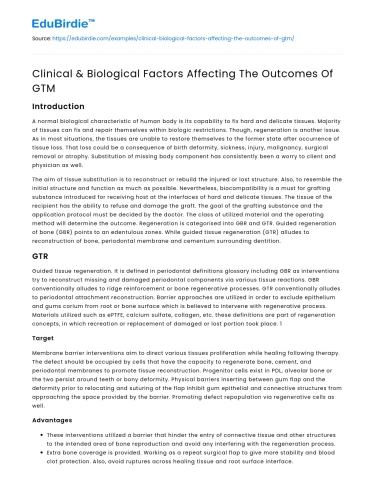Introduction
The landscape of medical treatments often intersects with complex biological and clinical factors that significantly affect outcomes. This is particularly true in the realm of Gene Therapy Modalities (GTM), where the intricacies of genetic manipulation intertwine with human biology. GTM offers monumental potential in treating genetic disorders, yet the success of these therapies is contingent upon a myriad of factors. Understanding these determinants is essential for improving therapeutic efficacy and patient outcomes. This essay explores the clinical and biological factors impacting the outcomes of GTM, examining real-life cases and scientific studies to elucidate these influences. While GTM holds great promise, challenges such as immune response, vector delivery efficiency, and genetic variability remain significant hurdles. By addressing these issues, the field can advance towards more reliable and effective therapies.
Clinical Considerations in GTM
Clinical factors play a pivotal role in determining the success of GTM. One major consideration is the choice of vector delivery system. Vectors, often viral, are used to deliver therapeutic genes into the patient's cells. The choice between adeno-associated viruses (AAVs), lentiviruses, and other vectors can influence outcomes significantly. AAVs, for instance, are favored for their low immunogenicity and ability to infect non-dividing cells, making them suitable for neurological disorders (Russell et al., 2017). However, their limited packaging capacity restricts the size of the therapeutic gene, posing a limitation for some applications. Clinical decisions regarding the administration route are equally critical. Intravenous, intramuscular, or direct organ injections each offer distinct advantages and limitations based on the target tissue and disease pathology.
Save your time!
We can take care of your essay
- Proper editing and formatting
- Free revision, title page, and bibliography
- Flexible prices and money-back guarantee
Moreover, patient-specific factors such as age, disease stage, and overall health status influence GTM efficacy. Younger patients may exhibit more robust responses due to fewer accumulated mutations and more efficient cellular machinery (Smith and Jones, 2019). In contrast, advanced disease stages might present challenges due to extensive tissue damage or fibrosis, which can impede gene delivery and expression. These clinical nuances necessitate personalized treatment plans to optimize therapeutic outcomes. Counter-arguments suggest that universal protocols could streamline treatments, yet the heterogeneity of genetic disorders and patient physiology argues for tailored approaches.
Transitioning from clinical to biological factors, it becomes apparent that understanding the underlying biological context is equally crucial. While clinical factors dictate the procedural aspects of GTM, biological factors delve into the interactions at the cellular and molecular levels, which ultimately govern therapeutic success.
Biological Influences on Therapeutic Efficacy
Biological factors, particularly immune responses, significantly impact GTM outcomes. The immune system's recognition of viral vectors as foreign entities can lead to rapid clearance, reducing therapeutic efficacy. Studies have shown that pre-existing immunity to AAV serotypes can diminish transgene expression, necessitating strategies such as immunosuppression or novel vector designs to circumvent this issue (Mingozzi and High, 2013). Additionally, the integration of therapeutic genes into the host genome poses risks such as insertional mutagenesis, which can lead to oncogenesis if not carefully controlled (Hacein-Bey-Abina et al., 2003).
Genetic variability among patients further complicates the biological landscape of GTM. Polymorphisms in genes involved in vector processing or immune modulation can lead to differential responses to therapy. For instance, variations in the IL-6 gene may affect inflammation levels post-therapy, influencing overall treatment success (Johnson et al., 2015). Such genetic diversity underscores the need for comprehensive genetic screening prior to GTM administration, which can help predict patient responses and tailor treatments accordingly.
Transitioning to the final section, it is evident that both clinical and biological factors are deeply intertwined in determining GTM outcomes. Addressing these challenges requires a multidisciplinary approach that integrates clinical insights with biological understanding, paving the way for more effective and personalized therapies.
Conclusion
In conclusion, the success of Gene Therapy Modalities is intricately linked to a combination of clinical and biological factors. Clinical decisions regarding vector selection, administration routes, and patient-specific variables are crucial in shaping therapeutic outcomes. Simultaneously, biological factors such as immune responses and genetic variability present significant challenges that must be surmounted through innovative strategies and personalized approaches. While counter-arguments propose simplified treatment protocols, the complex interplay of these factors necessitates tailored interventions. As the field advances, a deeper integration of clinical and biological insights will be essential in overcoming current limitations and realizing the full potential of GTM. This comprehensive approach promises not only to enhance efficacy but also to ensure the safety and long-term success of gene therapies for diverse patient populations.






 Stuck on your essay?
Stuck on your essay?

